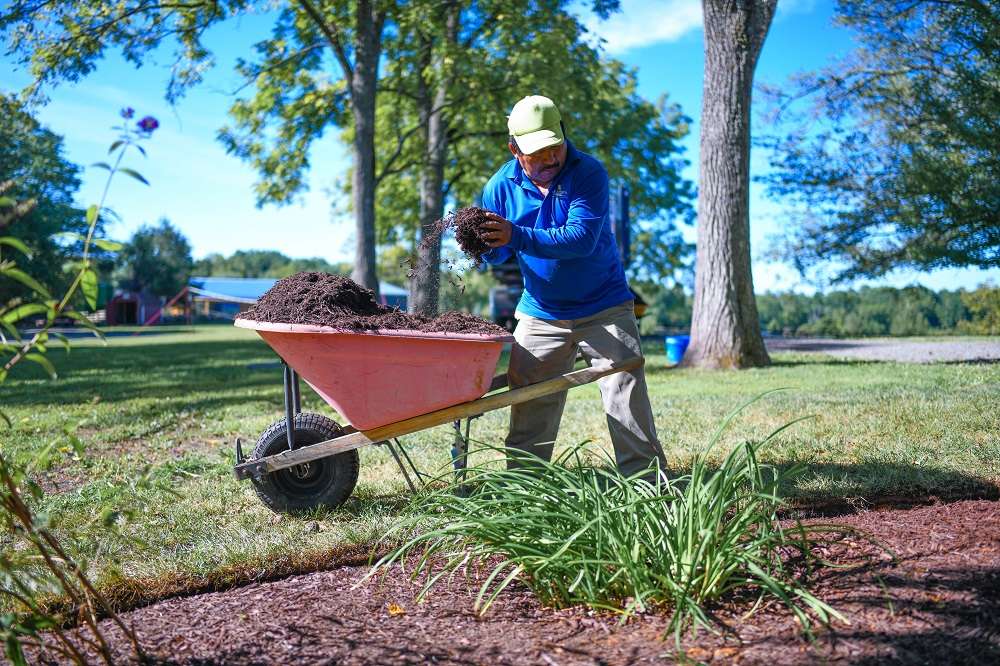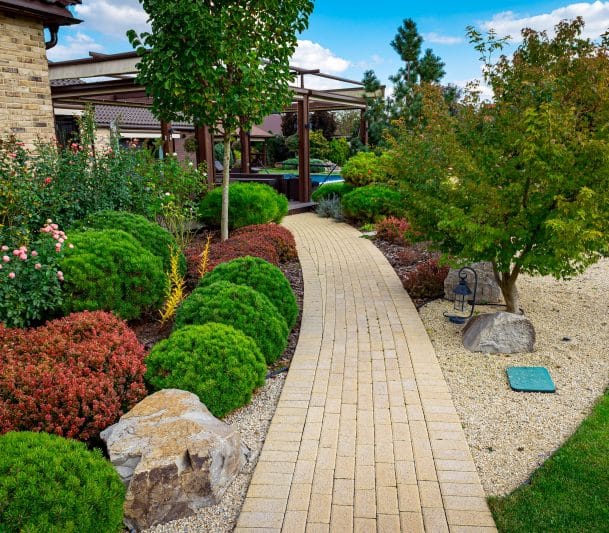Pro insights for hiring reliable landscaping services
Recognizing the Comprehensive Scope of Works in Specialist Landscape Design Services
The comprehensive scope of professional landscaping services incorporates a range of basic elements. It includes landscape design principles, plant choice, and hardscaping attributes. Additionally, it deals with watering systems and upkeep approaches. Each facet plays a crucial role in producing practical and cosmetically pleasing exterior spaces. Comprehending exactly how these elements interact can expose much concerning the art and scientific research of landscaping. The trip right into this elaborate area is simply beginning.
Landscape Design Concepts
Effective landscape design principles are essential for creating harmonious outdoor spaces that enhance both visual allure and performance. These principles lead the arrangement of aspects within the landscape, ensuring a cohesive aesthetic experience. Trick parts include balance, which disperses aesthetic weight evenly; percentage, which connects the size of different elements to each various other and the room; and unity, which creates a feeling of integrity with regular themes and materials.
Focus directs interest to focal points, while rhythm establishes activity via repetition of design functions. The efficient usage of line can create pathways and guide the eye through the landscape. In addition, recognizing the website's topography, climate, and existing functions is important for assimilation with the surrounding environment. By sticking to these foundational concepts, landscape developers can craft spaces that not just look appealing but likewise offer their designated function, enhancing the overall experience for individuals.
Plant Selection and Installation
In the domain of professional landscape design, plant choice and installment play an essential duty in attaining a flourishing garden - landscaping. Emphasizing indigenous plant benefits, seasonal factors to consider, and the specific dirt and sunlight needs of each types guarantees a lasting and cosmetically pleasing landscape. Mindful preparation in these areas not only boosts biodiversity yet additionally promotes long-term ecological health
Native Plant Advantages
Why should homeowners think about indigenous plants for their landscape design jobs? Indigenous plants offer various benefits that enhance both looks and ecological sustainability. They are well-adapted to neighborhood environments, needing less water and maintenance contrasted to non-native species. This strength lowers the demand for chemical plant foods and chemicals, promoting a healthier ecological community. Additionally, indigenous plants give environment and food for regional wild animals, consisting of pollinators, which can boost biodiversity in houses. Their knowledge with neighborhood soil and weather conditions additionally results in far better development prices and long life. By selecting indigenous plants, property owners not only create aesthetically appealing landscapes however additionally contribute to environmental preservation, making a favorable effect on their local atmosphere. Indigenous plants stand for a smart option for landscape design projects.
Seasonal Plant Considerations
Home owners who have welcomed indigenous plants in their landscaping can even more improve their outside areas by taking into consideration seasonal plant selections. By incorporating plants that grow in certain seasons, they can develop vibrant and visually attractive landscapes throughout the year. Springtime may usher in vibrant blossoms like tulips and daffodils, while summertime can showcase lavish vegetation and vibrant perennials. Autumn introduces a palette of cozy tones with asters and goldenrods, while winter can be emphasized with evergreens and decorative lawns for texture. Expert landscaping companies usually suggest choosing plants that not only enhance existing indigenous types however also offer year-round rate of interest and support regional wild animals. This thoughtful approach to seasonal plant choice ensures a consistently advancing and sustainable garden setting.
Dirt and Sunlight Needs
Successful landscaping hinges on understanding the particular dirt and sunshine requirements of plants. Different types thrive under varying conditions, requiring a cautious assessment of both factors throughout the choice procedure (landscaping services). Dirt types, such as sandy, clay, or fertile, impact water drainage, nutrient availability, and origin advancement. Furthermore, pH degrees can affect plant health and wellness, necessitating dirt testing to identify viability. Sunlight needs differ substantially; some plants thrive in full sunlight, while others favor full or partial shade. A specialist landscaping company considers these elements to ensure peak development and visual allure. By aligning plant selections with the setting's particular characteristics, landscapes can achieve sustainability, resilience, and visual consistency, eventually leading to successful plant facility and long-term upkeep
Hardscaping Features and Construction
While landscaping often stimulates pictures of lush greenery and vivid blossoms, hardscaping features play a crucial duty in specifying exterior spaces. These elements, that include outdoor patios, sidewalks, preserving walls, and ornamental stonework, give framework and performance to yards and yards. Hardscaping uses products such as concrete, timber, rock, and block, enabling diverse layouts that match the natural landscape.
The building and construction of hardscaping features requires mindful planning and implementation to assure longevity and aesthetic appeal. Professionals assess site conditions, drain, and spatial relationships to create cohesive outdoor settings. Appropriate installment strategies are essential, as they avoid issues like erosion and changing with time.
Integrating hardscaping not just enhances the visual passion of a residential or commercial property yet also assists in exterior activities, making it a basic element of complete landscaping services. Eventually, thoughtful hardscaping adds to both the capability and elegance of exterior spaces.
Watering Equipments and Water Monitoring
Efficient watering systems and water management are vital parts of professional landscape design, as they ensure that plants get the needed hydration for ideal development. These systems can vary from simple drip watering configurations to innovative automated automatic sprinkler, designed to fulfill the details demands of diverse landscapes. Correct water administration not only optimizes water usage, minimizing waste, but additionally boosts plant health and lessens illness threats.
Landscape design experts examine different aspects, including dirt kind, plant species, and regional environment, to establish customized irrigation remedies. In addition, incorporating rainwater harvesting techniques can better enhance sustainability and performance (Read More). Regular maintenance of watering systems is important to preserve functionality and protect against leaks, which can cause water loss and enhanced costs. Inevitably, a well-designed irrigation system plays an essential function in protecting the aesthetic charm of exterior rooms while promoting eco-friendly stewardship within specialist landscaping practices
Lawn Treatment and Maintenance Techniques
Yard treatment and upkeep approaches are essential for attaining a lush, healthy backyard that enhances the total landscape. These techniques include various practices aimed at advertising excellent growth and visual appeal. Normal mowing is important, as it encourages thick, also development while preventing weeds from developing. In addition, proper fertilization offers required nutrients, with applications customized to the particular lawn kind and dirt problems.
Watering methods ought to focus on deep, occasional irrigation to urge root advancement, while aeration improves soil framework and advertises nutrient absorption. Pest and disease administration is also important; determining issues early permits effective therapies that minimize damages.
Overseeding can invigorate damaged or thin lawns, improving thickness and shade. By implementing these targeted yard treatment strategies, landscape design professionals can guarantee that lawns stay lively and healthy throughout the seasons, substantially adding to the general beauty of the residential property
Seasonal Landscape Care and Maintenance
As the seasons adjustment, appropriate landscape treatment becomes crucial for maintaining the health and wellness and charm of outdoor spaces. Each period offers distinct obstacles and demands. In springtime, landscape experts concentrate on trimming, growing, and feeding to encourage growth. Summer season needs normal watering, weed control, and pest administration to shield freshly developed plants.
Autumn requires the preparation of gardens for winter months, including mulching, leaf removal, and the growing of bulbs for the following springtime. In addition, winter care involves safeguarding prone plants from frost and guaranteeing that hardscapes are secure and functional.
Throughout the year, seasonal landscape upkeep warranties that outdoor areas remain healthy and aesthetically enticing. Specialist services can provide customized upkeep strategies that adapt to the certain demands of each period, enabling residential property proprietors to enjoy dynamic landscapes year-round. In general, seasonal care is an important element of expert landscape design that advertises long life and visual value.
Sustainable Landscape Design Practices
A growing number of building proprietors are accepting sustainable landscaping techniques to develop eco-friendly outdoor spaces. These techniques concentrate on conserving sources, boosting biodiversity, and lessening ecological effect. Native plants are frequently chosen for their low tide needs and compatibility with neighborhood environments, reducing the need for chemical fertilizers and chemicals. Rainfall gardens and permeable paving are utilized to take care of stormwater overflow, promoting groundwater recharge and decreasing erosion.
Additionally, lasting landscaping incorporates natural gardening techniques that focus on soil health and advertise natural parasite control. Effective watering systems, such as drip watering and rainwater harvesting, help enhance water usage. Furthermore, landscape developers significantly advocate for the use of recycled products, such as reclaimed wood and rocks, to minimize waste. By embracing these sustainable techniques, homeowner not only add to eco-friendly preservation yet also produce cosmetically pleasing environments that can love marginal maintenance.
Regularly Asked Questions
The length of time Does a Landscape Design Project Usually Take to Complete?
Normally, a landscape design project can take anywhere from a few days to a number of weeks to complete, depending upon the job's style, size, and complexity requirements. Learn More. Factors such as weather and source schedule likewise affect timelines
What Variables Impact the Expense of Landscaping Services?
Numerous aspects affect landscape design service costs, consisting of job size, design intricacy, worldly high quality, labor expenses, geographical location, and seasonal demand. Each component adds distinctively to the total economic demands of a landscape design task.
Are Landscaping Services Available Year-Round?
Landscape design services are typically available year-round, although accessibility may differ based upon region, seasonal climate condition, and details service offerings. Some services could be limited during severe weather or off-peak periods.
Do Landscaping Firms Offer Service Warranties on Their Job?

Can I Layout My Landscape Without Professional Assist?
Yes, individuals can create their landscapes without professional assistance. Nonetheless, they might lack proficiency in plant option, layout, and ecological considerations, potentially bring about much less reliable designs that might require pricey changes later on.
